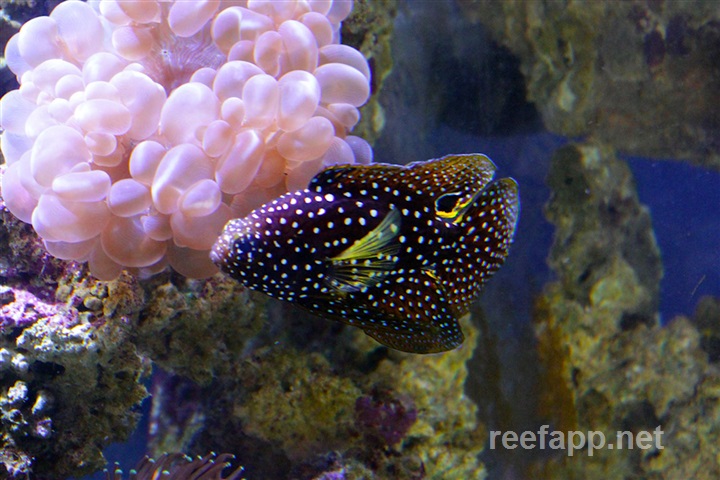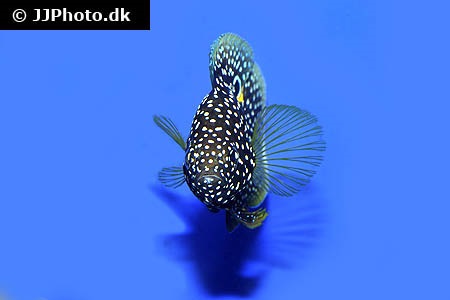Calloplesiops altivelis
| Latin name | Calloplesiops altivelis - (Steindachner, 1903) |
|---|---|
| Local name | Comet |
| Family | Plesiopidae - Calloplesiops |
| Origin | East Indian Ocean, West Indian Ocean, Australia, The Red Sea, Indonesia, East Pacific, Central/West Pacific |
| Max length | 16 cm (6.3") |
| Minimum volume |
300 l (79 gal) |
|---|---|
| Hardiness |
Hardy |
| Suitable for aquarium |
Suitable with care |
| Reef safe |
Reef safe with caution |
| Aggressiveness | Docile |
| Recommended |
Fish Larger crustaceans (Shrimp, crabs...) Other invertebrates Small crustaceans (Krill, mysis, artemia...) |
|---|
This species may eat small fish and especially small shrimps, there are, however, some aquarists who manage to get them to coexist just fine.
This species must be fed with an appropriately varied diet.
There is a greater chance of success with this species if one can supply a living feed to allow it to adapt to the tank.
Out in wild this species is used to faint light, so to acclimitize it, it is advantageous to dim the light at first and gradually increase it to normal.
These fish may well hide themselves for a while, whilst getting acclimatized.
Do not disturb the fish while acclimating because it will prolong the process.
A very secretive species which hides between the rocks.
When it feels at home in the aquarium it will appear more, but is still not as active in the water column as most of the other fish.
This species can live with many of its own kind, when provided with enough space.
This species is very shy and docile, so one should be careful when keeping it with more aggressive fish.
This species can be bred in captivity, one can therefore consider asking your local fish store for a captive bred specimen.
Calloplesiops altivelis is the only species of the Calloplesiops genus.
There was thought to be another species, Calloplesiops argus, as the fish develops spots as an adult.
These spots on the fins merge into each other when the fish is fully grown.
These fish mimic Morays (Gymnothorax meleagris) when feeling threatened, by swimming into a hole and sticking their tail out.
There are several intriguing species of Roundheads (Plesiopidae) which are both interesting and easy to keep.
In the wild, most species will stay hidden and hunt at night, they mimic this behaviour in the aquarium so they are not often seen during daylight hours, although they will appear more in time.
These fish are generally quite hardy if given a varied diet.
They are not well suited to tanks with fast or aggressive fish, as they might hide and therefore not get sufficient food.
One should avoid keeping them with Hawkfish, Triggerfish and aggressive Wrasses for example.
Below are short descriptions of the species most suited to aquaria.
Assessors
Pretty, small fish that somewhat resemble Grammas and Dottybacks.
They are hardy, max. 2.5 inches (6 cm) and reasonably peaceful. Suitable for both coral and nano aquariums.
Calloplesiops
A unique fish which is hardy when fed correctly, but does require extra attention when adjusting to life in captivity. They will not thrive when kept together with aggressive species.
Plesiops
These fish are very aggressive and not often seen in aquaria.
Most species do not get very big and can therefore be kept in smaller tanks.
| Distribution | Indo-Pacific: Red Sea and East Africa to Tonga and the Line Islands. |
|---|---|
| Danish common names |
Kometbars |
| English common names |
Marine betta Comet |
| French common names |
Comète à grandes nageoires |
| German common names |
Mirakelfisch |
Scott W. Michael. 2002. Aquarium Fish: The Comet (Calloplesiops altivelis) - Advanced Aquarist - (English)
Scott W. Michael. 2001. Basslets, Dottybacks & Hawkfishes: v. 2 (Reef Fishes) - TFH Publications / Microcosm Ltd. - (English)
Bob Fenner. The Roundheads: (for petfish types mainly Assessors), Family Plesiopidae - Wet Web Media - (English)




